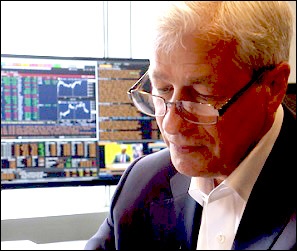JPMorgan's Historic Earnings Confirm that Fed Loans Are Subsidizing Profits on Wall Street
By Pam Martens and Russ Martens: January 15, 2020 ~
[Image] Jamie Dimon Sits in Front of Trading Monitor in his Office (Source: 60 Minutes Interview, November 10, 2019)
The New York Fed is back to subsidizing billions of dollars in profits at Wall Street's trading houses, just as it did during the financial crisis.
Yesterday, JPMorgan Chase reported that its profits for the quarter ending December 31, 2019 hit an all-time record. (The bank has been around for more than a century, so that's saying something.) The quarterly profits were $8.52 billion – for the same three-month period in which the New York Fed has been flooding unnamed Wall Street trading houses with hundreds of billions of dollars each week in super cheap loans.
The so-called "repo loans" by the New York Fed are being made at a fraction of where the free market would price loans to these Wall Street trading houses. On September 17, 2019 the first day the Fed began this open money spigot to Wall Street, the market wanted to price these loans at 10 percent. The New York Fed intervened with a flood of cheap money to bring the rate down and has been making the loans at less than 2 percent since then.
Yesterday, the New York Fed pumped out $82 billion to unnamed trading houses on Wall Street at interest rates of between 1.55 and 1.57 percent.
The January 2012 issue of Bloomberg Markets magazine reported the whopping profits reaped by Wall Street's trading houses as a result of the below-market-rate loans the Fed made to them during the financial crisis, writing as follows:
"Bankers didn't mention that they took tens of billions of dollars in emergency loans at the same time they were assuring investors their firms were healthy. And no one calculated until now that banks reaped an estimated $13 billion of income by taking advantage of the Fed's below-market rates…"The report further noted that:
"The six biggest U.S. banks' share of the estimated subsidy was $4.8 billion, or 23 percent of their combined net income during the time they were borrowing from the Fed."One of the six largest U.S. banks, is, of course, JPMorgan Chase.
In a March 26, 2010 letter to shareholders, Jamie Dimon, Chairman and CEO of JPMorgan Chase, attempted to spin his bank's use of the Fed's money spigot:
First he wrote this:
"We do not borrow 'cheap' from the Federal Reserve or any other source; we borrow at market rates, like everyone else does."Then he must have had a pang of conscience and wrote this later in the same missive to shareholders:
"We did participate in the Federal Deposit Insurance Corporation (FDIC) guarantee program, under which we issued $40 billion of debt with an FDIC guarantee. Many banks that used this program would not have had access to the capital markets without this guarantee and possibly could have failed. For JPMorgan Chase, it was not a question of access or need – to the extent we needed it, the markets always were open to us – but the program did save us money. As part of this program, we have paid the FDIC $1.3 billion, and, after paying the FDIC, it will save us a significant amount of money over the next few years.
"Our company was highly criticized for accepting the TARP capital and for using the FDIC program. After April 1, 2009, even though we were eligible to continue using the FDIC program, we stopped using it. There were many other government programs (with acronyms such as TALF and PPIP) that we believe were beneficial to the capital markets, but that we did not need and chose not to use, so as to avoid the stigma. (We did use the Term Auction Facility (TAF), a special government-sponsored depository facility, but this was done at the request of the Federal Reserve to help motivate others to use the system.)"TAF is not the only cheap-interest-rate Fed program that JPMorgan Chase tapped during the financial crisis. According to the academic researchers who compiled data on Fed loans during the financial crisis for the Levy Economics Institute, JPMorgan Chase received a cumulative tally of $456.9 billion just from the Fed – not including its help from the FDIC. According to the audit of Fed loans to Wall Street belatedly conducted by the Government Accountability Office in 2011, it showed that JPMorgan had tapped the following cheap-interest loan programs offered by the Fed (cumulative totals): $99 billion from the Term Auction Facility; $112 billion from the Primary Dealer Credit Facility; $68 billion from the Term Securities Lending Facility; and $111 billion from the Asset-Backed Commercial Paper Money Market Mutual Fund Liquidity Facility for a cumulative total of $390 billion. That number falls short of the dollar amount calculated by the Levy Economics Institute data because the GAO did not include all of the Fed's cheap money programs.
Please go to Wall Street on Parade to read the entire article.
________
Related:
Tariffs Are Having a Bigger Effect on U.S. Manufacturing Than Initially Thought
News update for 16 January 2020:
Capitalism in America: How a Dismal Decimal is Robbing Americans Blind
Russia will further turn away from dollar as US pursues 'aggressive' sanctions policy – Lavrov
Russian Gold, Foreign Reserves Reach A Record High As US Pursues Aggressive Sanctions Policy
Related news update for 17 January 2020: China's Growing Economic
Related news update for 17 January 2020: Here's How the Fake Unemployment Number Was Created to Subdue Anger Against Wall Street
An ongoing slaughter of people...
Giants: Who Really Rules The World?
Got some magic for you...
Virginia Gun Rally Looks Like A Trap, 2909

No comments:
Post a Comment
Note: Only a member of this blog may post a comment.